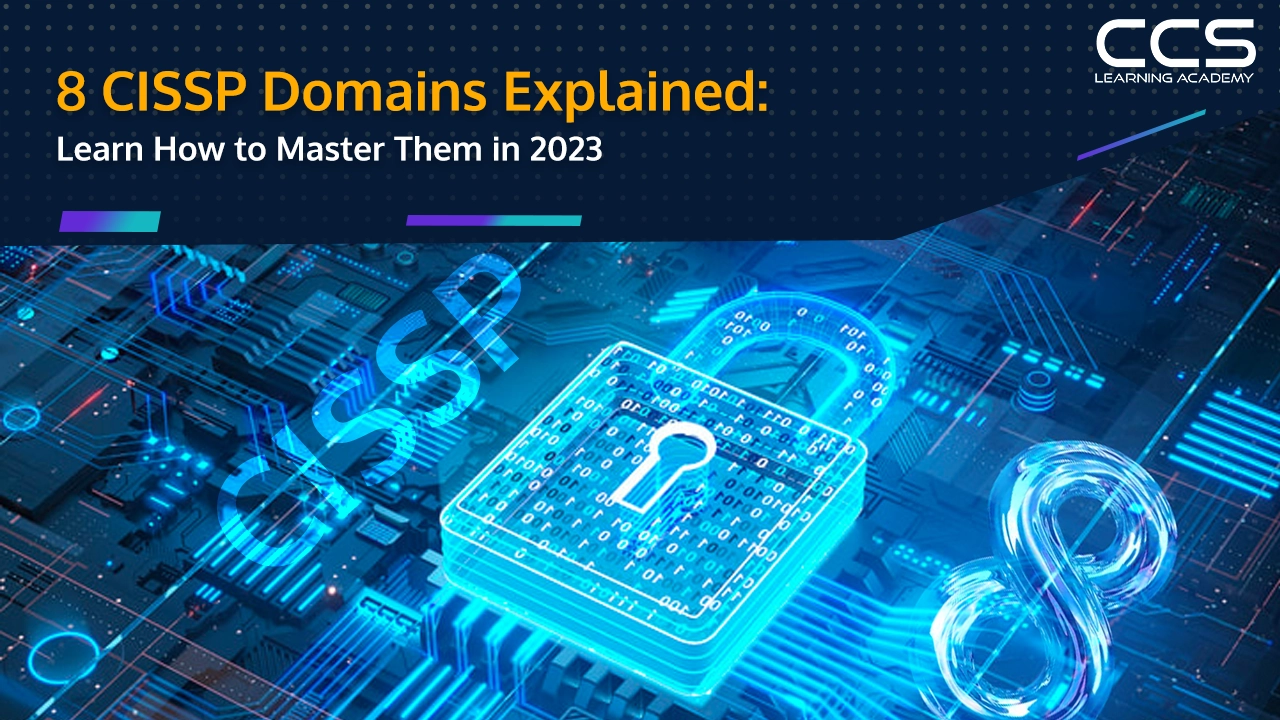8 CISSP Domains Explained: Learn How to Master Them in 2023
- -
- Time -

Professionals working in the IT security industry interested in exploring cybersecurity specialization must know about the Certified Information Systems Security Professional (CISSP) certification. Global enterprises are expanding their digital ecosystem with digital transformation.
As a result, they need experts who can protect their data and sensitive information against cyberattacks. So, the demand for cybersecurity professionals with CISSP certification is high as these security experts protect enterprise systems and networks against known and unknown cyber-attacks.
The global cybersecurity market is expected to reach $538.3 billion by 2030. Business leaders continue to increase their investment in IT technologies and security systems. Employers will instantly know that you know the intricacies of IT security and network security when you possess CISSP certification.
In this blog post, let’s dive deep into the various CISSP domains, their significance, and how you can clear the CISSP exam easily.
Table of Contents
- What is CISSP Certification?
- How to Become a CISSP Certified Professional?
- Overview of the CISSP Exam
- Understanding the ISC2 CISSP CBK
- Overview of 8 CISSP Domains
- 7 Tips for Mastering 8 CISSP Domains
- Passing Criteria for the CISSP Exam
- CISSP Certification Cost and Renewal Policy
- Additional Resources for CISSP Exam Preparation
- Conclusion
- FAQ
What is CISSP Certification?
The CISSP certification certifies IT security professionals and validates their competency. The International Information System Security Certification Consortium ISC2 is the authority for issuing this certification.
It also created a Body of Knowledge (CBK) to include all the information that expert cybersecurity professionals need to know. According to a Workforce Study, employers expect 72% of cybersecurity professionals to acquire specialized certifications.
CISSP-certified professionals have great earning potential. The average salary for CISSP-certified professionals is $140,000. Employers will know you are a top security professional if they see CISSP certification in your resume.
CISSP-certified professionals must maintain the certification, showing their employers they are committed to continuous learning. It will help you acquire subject expertise and gain a deeper knowledge of cybersecurity topics. Your CISSP certification will also qualify you to become an (ISC)2 member, and you can network with other (ISC)2 professionals.
How to Become a CISSP Certified Professional?
You may want to complete this certification course immediately after completing your Bachelor’s degree for better job prospects. However, CISSP certification has some prerequisites that you must meet. CISSP is a certification process for advanced security professionals.
To take this examination, you must demonstrate at least five years of full-time employment experience in entry-level cybersecurity jobs. Alternatively, if you have a Bachelor’s degree in cybersecurity or related fields, you can take this exam after completing four years of full-time work in the related field. Also, you must demonstrate proficiency in at least 2 out of 8 domains of CISSP.
If you have education, professional credentials, and work experience, you can enroll for the CISSP exam preparation course to study for the examination with the help of industry experts and leading tutors. You can also use the internet resources to self-learn. However, the preparatory course syllabus will improve your examination readiness.
Overview of the CISSP Exam
Once ready to take the CISSP examination, you must register through the official ISC2 website. You must use the practice exams and study materials available on the website to learn more about the certification requirements. You must register online, but the examination is usually conducted at the VUE testing center, which you can choose at the time of registration.
After passing the exam, you should look for another certification holder to endorse you, validating your knowledge as a CISSP certificate holder. If you can’t find another professional to endorse you within nine months of passing the exam, you can approach ISC2 to act as your endorser.
Understanding the ISC2 CISSP CBK
The CISSP Common Body of Knowledge (CBK) is a complete framework of all subjects a cybersecurity professional must know. It includes all types of security skills, techniques, methodologies, and best practices for cybersecurity professionals.
The ISC2 has categorized the CBK into CISSP CBK domains to organize security topics. In the CISSP examination, candidates will be tested on each domain to ensure they understand all the critical aspects of information, data, applications, systems, and network security.
Overview of 8 CISSP Domains
As a continuous commitment to the members of (ISC)2, the consortium conducts Job Task Analysis (JTA) to ensure the relevancy of CISSP. The results of the study are used to update the examination.
This is important to ensure that the candidates who take the CISSP exam are tested in the latest and relevant subjects corresponding to the updated job roles and responsibilities in the cybersecurity industry.
The competencies of the candidates are tested on 8 different CISSP domains.
Below is the CISSP domains list:
1. Security and Risk Management
This domain explores all the basic security control frameworks and governance principles. The exam questions will test you based on ISO 27001, 27002, COBIT, Cloud Security Alliance’s CSA Start framework, etc. You must also learn about the CIA security principle that ensures confidentiality, integrity, and availability. This explores security methodologies to keep data private and stop unauthorized modifications while ensuring availability.
Candidates will also learn about security governance fundamentals and management. It also identifies and quantifies threats based on risk levels and business continuity requirements. As a part of governance, establishing procedures, standards, principles, policies, and guidelines is also important, and cybersecurity professionals should learn about it.
2. Asset Security
This domain dives deep into digital assets, identification, classification, and ownership. Cybersecurity professionals need a complete understanding of the existing digital assets. You must learn data security controls, handling, labeling, and secure data storage procedures. Understanding data retention and privacy is also important for ensuring asset security.
3. Security Architecture and Engineering
This domain covers security design principles and models. Security architecture is an important aspect of cybersecurity that governs access control and security assessment. The security architecture varies based on the enterprise IT environment. Different methodologies are necessary for web-based, cloud-based, mobile, IoT, and embedded systems.
Security professionals must know about security vulnerabilities and their relevance in real-world situations. This domain also covers physical security principles that physically protect the facility, its design, and operations.
4. Communications and Network Security
In this domain, candidates will learn about secure network architecture design. Different network protocols, like OSI and TCP/IP, have different security needs. While learning about communications and network security, you will learn about Wi-Fi protection, instruction detection and prevention systems, network access control, and endpoint security.
After covering this domain, candidates can design secure communication channels. They will also learn virtualized network technologies from basic VLANs to advanced Software-Defined Networking (SDN) networks. You also must have a good understanding of basic network protection techniques.
5. Identity and Access Management
Cybersecurity professionals must know how to manage and use user identities for user authentication. Enterprises expect security experts to control asset access, including systems, devices, and files. Security professionals must determine and establish directories and database permissions. The physical security of facilities should never be ignored.
Several tools are available to implement Identity and Access Management (IAM). They must know authentication policies like Multi-Factor Authentication (MFA) and Single Sign On (SSO). The security team is responsible for granting privileges and access controls for multiple enterprise systems.
By learning this domain, you will understand cloud-based identity services, registering and managing identity information, identity provisioning, access reviews, and requests.
6. Security Assessment and Testing
Those who want to work in the cybersecurity industry must know assessment and testing to identify security availability. You will learn about security controls, operations, and management in this domain. Cybersecurity individuals must know the basics of security control testing. Penetration testing is one of the advanced cybersecurity concepts where you will do port and vulnerability scanning to break into software and systems.
This domain also explores multiple ways to review logs and application source code to uncover vulnerabilities. The testing methods will enable you to test the enterprise systems for security and resilience. You must also learn to design security audits to understand the enterprise’s security architecture accurately.
7. Security Operations
You will explore all the CISSP concepts from an operational perspective in this domain. You will learn how to implement day-to-day security operations like investigations, incident management, and disaster recovery. You will learn essential concepts like security information and event management (SIEM), intrusion detection, and prevention.
Reviewing security logs will only shed light on security events. Cybersecurity professionals must also know incident management operations like detection, investigation, response, mitigation, and reporting. They must also know secure resource allocation, protection, and monitoring for completing enterprise tasks. To ensure business continuity, you must learn disaster recovery strategies, personal management, communications, and disaster recovery.
8. Software Development Security
Professionals involved in cybersecurity must also learn how to implement security in software development. To create appropriate security standards, you must learn waterfall and agile development cycles and software maturity models.
7 Tips for Mastering 8 CISSP Domains
Acquiring CISSP certification is rewarding in terms of better job prospects and higher salaries. However, passing the examination on the first attempt is difficult.
Following are some tips that can help you to master ISC2 CISSP domains:
- Understand exam outline and details and ensure you have the latest information on domain topics
- Create a customized study plan after reflecting on your strengths and weaknesses
- Sign up for a CISSP preparatory course and soak up knowledge shared by mentors and tutors
- Take as many practice exams as possible
- Join online communities and forums and discuss cybersecurity operations
- Use multiple resources to study for the exam
- Create a detailed plan for exam day
Passing Criteria for the CISSP Exam
To get CISSP certification, you must score at least 700 out of 1000 marks. Passing the CISSP exam on your first attempt requires a great deal of preparation and training. If you don’t clear the exam the first time, you can make multiple attempts after waiting for 30 days after the first time. You can take the exam a maximum of four times a year.
Do You Need to Pass All the CISSP Domains?
The CISSP exam is a Computerized Adaptive Test (CAT). The number of questions and level of difficulty is based on individual candidate performance. To increase your chance of passing the exam, you have to be proficient in all CISSP security domains. During the exam, you have to reach a level of proficiency in each domain.
The CISSP exam domains have different weightage. Some of the questions are pre-test questions designed to qualify you for future exams. However, candidates will not know the difference between pre-test and actual scored questions. ISC2 takes these measures to ensure that only competent professionals qualify for certification.
So, you don’t have to reach 70% in each domain, but you must obtain a weighted score of 700 after answering all domains. At the same time, it doesn’t meant that you can pass the exam after getting all the answers wrong in a domain. The aim of CISSP test is to ensure that you are proficient in all of the CISSP domains.
CISSP Certification Cost and Renewal Policy
The CISSP examination fee is $749. However, learning for the examination on your own is tedious and time-consuming. You must also be ready to spend on exam preparation. The training programs and preparatory courses will help you to learn better and prepare properly for the examination. Based on your choice, you can choose self-paced learning courses or instructor-led training. You can also learn as a part of a team and get hands-on experience in various advanced cybersecurity concepts.
CISSP professionals must maintain their certification by renewing it every 3 years. You must also pay an annual fee of $125 to (ISC)2. You must earn 120 credits for continuing professional education (CPE) to renew your certificate. You can earn these credits by attending cybersecurity events, courses, webinars, conferences, teaching, or volunteering. The costs for earning credits vary based on how you wish to acquire them.
Additional Resources for CISSP Exam Preparation
Referring to as many resources as possible for CISSP exam preparation will help you pass the examination easily. Some of the highly recommended resources for CISSP exam preparation are:
- Ultimate Guide to the CISSP (Free ISC2 PDF)
- CISSP Exam Outline 2021 (Free ISC2 PDF)
- Sunflower Study Guide (Free PDF)
- Official ISC2 Study App – Apple, Android
- CISSP Pocket Prep App – Apple, Android
- Last year’s (2022) FRSecure CISSP Mentor Program session recordings
- Official ISC2 flashcards (Free gated resource)
- Official ISC2 practice tests
Conclusion
If you are interested in cybersecurity, continuous learning and upskilling are essential to move up your career ladder. After gaining four or five years of industry experience, you should set the goal of obtaining CISSP certification.
It not only helps you to stay updated on the current cybersecurity topics and CISSP domains but will also help you to secure a higher-paying job. Understanding the exam pattern, signing up for preparatory courses, and preparing with the focus of passing the examination will help you clear the exam on the first attempt.
Interested in acquiring tech skills to secure better jobs in the cybersecurity field? CCS Learning Academy provides a Cybersecurity Bootcamp to jumpstart your career. Looking for upskilling? Enroll in the CISSP preparatory course to prepare easily for one of the advanced cybersecurity certification exams and pass on the first attempt.
FAQ
Q1: What are the 8 domains of the CISSP certification?
The eight domains of the CISSP (Certified Information Systems Security Professional) certification are Security and Risk Management, Asset Security, Security Architecture and Engineering, Communication and Network Security, Identity and Access Management (IAM), Security Assessment and Testing, Security Operations, and Software Development Security.
Q2: What is covered in the Security and Risk Management domain?
The Security and Risk Management domain focuses on understanding and applying security governance principles, compliance, ethics, security policies, procedures, and risk management concepts.
Q3: Can you explain the scope of the Asset Security domain?
The Asset Security domain covers the protection of an organization’s assets, including data classification, handling, and ownership, as well as asset retention and disposal.
Q4: What topics are included in the Security Architecture and Engineering domain?
The Security Architecture and Engineering domain delves into security models, principles, and cryptography, as well as secure design principles for various systems and architectures.
Q5: What is the focus of the Communication and Network Security domain?
The Communication and Network Security domain explores secure network architecture, communication channels, and the principles of secure network components and protocols.
Q6: Can you explain the core concepts of the Identity and Access Management (IAM) domain?
The Identity and Access Management (IAM) domain addresses access control, authentication, authorization, identity management, and identity provisioning.
Q7: What does the Security Assessment and Testing domain cover?
The Security Assessment and Testing domain discusses security assessment processes, security control testing, and security assessment tools and techniques.
Q8: What are the topics included in the Security Operations domain?
The Security Operations domain encompasses security operations concepts, investigations, incident management, disaster recovery, and business continuity planning.
Q9: What is the significance of the Software Development Security domain?
The Software Development Security domain focuses on security in the software development lifecycle, including secure coding practices, application security, and software development processes.
Q10: How should I prepare for the CISSP exam, considering these domains?
To prepare for the CISSP exam, you should study each domain thoroughly using study materials, practice exams, and training courses. Additionally, hands-on experience and real-world scenarios are valuable for mastering these domains.
Q11: Are there any recommended resources or study guides for each CISSP domain?
Yes, there are many recommended study guides and resources available for each CISSP domain. These include official (ISC)² study materials, CISSP review books, online courses, and practice exams.
Q12: What is the passing score for the CISSP exam, and how many questions are there in the test?
The passing score for the CISSP exam is 700 out of 1000 points. The exam consists of 250 multiple-choice and advanced innovative questions, and you have up to 6 hours to complete it.






